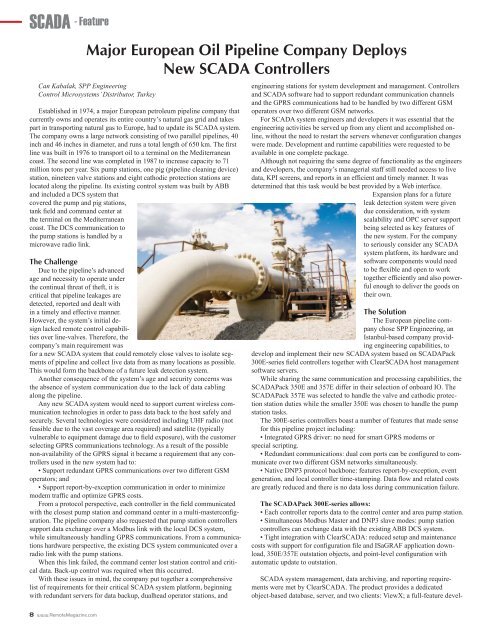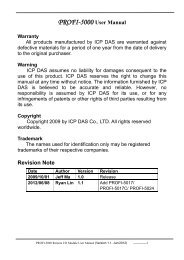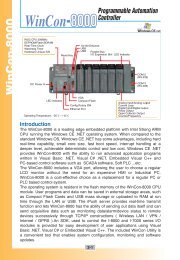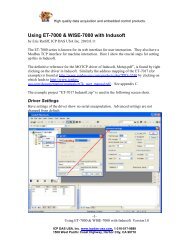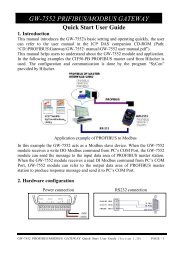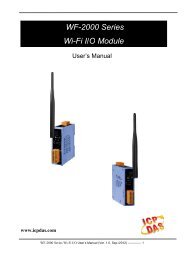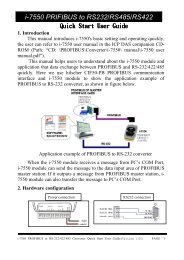Contents - ICP DAS USA
Contents - ICP DAS USA
Contents - ICP DAS USA
You also want an ePaper? Increase the reach of your titles
YUMPU automatically turns print PDFs into web optimized ePapers that Google loves.
SCADA - FeatureMajor European Oil Pipeline Company DeploysNew SCADA ControllersCan Kabalak, SPP EngineeringControl Microsystems’ Distributor, TurkeyEstablished in 1974, a major European petroleum pipeline company thatcurrently owns and operates its entire country’s natural gas grid and takespart in transporting natural gas to Europe, had to update its SCADA system.The company owns a large network consisting of two parallel pipelines, 40inch and 46 inches in diameter, and runs a total length of 650 km. The firstline was built in 1976 to transport oil to a terminal on the Mediterraneancoast. The second line was completed in 1987 to increase capacity to 71million tons per year. Six pump stations, one pig (pipeline cleaning device)station, nineteen valve stations and eight cathodic protection stations arelocated along the pipeline. Its existing control system was built by ABBand included a DCS system thatcovered the pump and pig stations,tank field and command center atthe terminal on the Mediterraneancoast. The DCS communication tothe pump stations is handled by amicrowave radio link.The ChallengeDue to the pipeline’s advancedage and necessity to operate underthe continual threat of theft, it iscritical that pipeline leakages aredetected, reported and dealt within a timely and effective manner.However, the system’s initial designlacked remote control capabilitiesover line-valves. Therefore, thecompany’s main requirement wasfor a new SCADA system that could remotely close valves to isolate segmentsof pipeline and collect live data from as many locations as possible.This would form the backbone of a future leak detection system.Another consequence of the system’s age and security concerns wasthe absence of system communication due to the lack of data cablingalong the pipeline.Any new SCADA system would need to support current wireless communicationtechnologies in order to pass data back to the host safely andsecurely. Several technologies were considered including UHF radio (notfeasible due to the vast coverage area required) and satellite (typicallyvulnerable to equipment damage due to field exposure), with the customerselecting GPRS communications technology. As a result of the possiblenon-availability of the GPRS signal it became a requirement that any controllersused in the new system had to:• Support redundant GPRS communications over two different GSMoperators; and• Support report-by-exception communication in order to minimizemodem traffic and optimize GPRS costs.From a protocol perspective, each controller in the field communicatedwith the closest pump station and command center in a multi-masterconfiguration.The pipeline company also requested that pump station controllerssupport data exchange over a Modbus link with the local DCS system,while simultaneously handling GPRS communications. From a communicationshardware perspective, the existing DCS system communicated over aradio link with the pump stations.When this link failed, the command center lost station control and criticaldata. Back-up control was required when this occurred.With these issues in mind, the company put together a comprehensivelist of requirements for their critical SCADA system platform, beginningwith redundant servers for data backup, dualhead operator stations, andengineering stations for system development and management. Controllersand SCADA software had to support redundant communication channelsand the GPRS communications had to be handled by two different GSMoperators over two different GSM networks.For SCADA system engineers and developers it was essential that theengineering activities be served up from any client and accomplished online,without the need to restart the servers whenever configuration changeswere made. Development and runtime capabilities were requested to beavailable in one complete package.Although not requiring the same degree of functionality as the engineersand developers, the company’s managerial staff still needed access to livedata, KPI screens, and reports in an efficient and timely manner. It wasdetermined that this task would be best provided by a Web interface.Expansion plans for a futureleak detection system were givendue consideration, with systemscalability and OPC server supportbeing selected as key features ofthe new system. For the companyto seriously consider any SCADAsystem platform, its hardware andsoftware components would needto be flexible and open to worktogether efficiently and also powerfulenough to deliver the goods ontheir own.The SolutionThe European pipeline companychose SPP Engineering, anIstanbul-based company providingengineering capabilities, todevelop and implement their new SCADA system based on SCADAPack300E-series field controllers together with ClearSCADA host managementsoftware servers.While sharing the same communication and processing capabilities, theSCADAPack 350E and 357E differ in their selection of onboard IO. TheSCADAPack 357E was selected to handle the valve and cathodic protectionstation duties while the smaller 350E was chosen to handle the pumpstation tasks.The 300E-series controllers boast a number of features that made sensefor this pipeline project including:• Integrated GPRS driver: no need for smart GPRS modems orspecial scripting.• Redundant communications: dual com ports can be configured to communicateover two different GSM networks simultaneously.• Native DNP3 protocol backbone: features report-by-exception, eventgeneration, and local controller time-stamping. Data flow and related costsare greatly reduced and there is no data loss during communication failure.The SCADAPack 300E-series allows:• Each controller reports data to the control center and area pump station.• Simultaneous Modbus Master and DNP3 slave modes: pump stationcontrollers can exchange data with the existing ABB DCS system.• Tight integration with ClearSCADA: reduced setup and maintenancecosts with support for configuration file and ISaGRAF application download,350E/357E outstation objects, and point-level configuration withautomatic update to outstation.SCADA system management, data archiving, and reporting requirementswere met by ClearSCADA. The product provides a dedicatedobject-based database, server, and two clients: ViewX; a full-feature devel-8 www.RemoteMagazine.com


